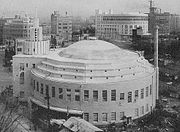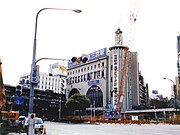Mikishi Abe
The topic of this article may not meet Wikipedia's notability guideline for biographies. (February 2012) |
Mikishi Abe | |
|---|---|
 SEIKO main office designed by Mikishi Abe | |
| Born | May 4, 1883 |
| Died | February 20, 1965 |
| Alma mater | University of Illinois Sapporo Agricultural College |
| Occupation(s) | Architect, civil engineer |
| Practice | Abe Offices |
| Buildings | Hankyu Department Store Hibiya Movie Theatre |
| Projects | Hankyu Hanshin Toho Group overhead railways |
Mikishi Abe (
Shortly after World War Two, he was the second president of the War Reconstruction Agency (currently the Ministry of Land, Infrastructure, Transport and Tourism) and the Secretary-General of the Construction Agency (Deputy Secretary of Construction) after the war. On March 4, 1947, he was appointed as a member of the Imperial House of Representatives, and remained in office until the abolition of the House of Peers on May 2, the same year.[2]
Mikishi Abe was the student of A.N Talbot of United States. He is credited of spreading the Talbot's message of pragmatism in Japan. [3]
Buildings
[edit]- Seiko Main Office
- Hibiya Movie Theater, Yurakucho, Chiyodaku, Tokyo, 1934[4]
- Meiji Seika Tobata Factory, Tobataku, KitaKyushu, 1936
- Hankyu Nishinomiya Stadium
- Kobe Hankyu Building
- Yuraku-za Theatre
Books
[edit]- Analysis and Tests of Rigidly Connected Reinforced Concrete Frames. [5]
References
[edit]- ^ "Abe Mikishi". Nihon jinmei daijiten+Plus. Kōdansha. Retrieved 13 February 2012.
- ^ House of Representatives, House of Councils, "Hundred Year History of Parliamentary System: Aristocratic House of Representatives Directory," Ministry of Finance, Printing Bureau, 1990, p. 90.
- ^ Sozen, Mete A.; Ichinose, Toshikatsu; Pujol, Santiago (14 July 2014). Principles of Reinforced Concrete Design. CRC Press. ISBN 978-1-4822-3148-9.
- ^ Hibiya Movie Theater
- ^ Abe, Mikishi (July 2008). Analysis and Tests of Rigidly Connected Reinforced Concrete Frames. Read Books. ISBN 978-1-4086-6693-7.




